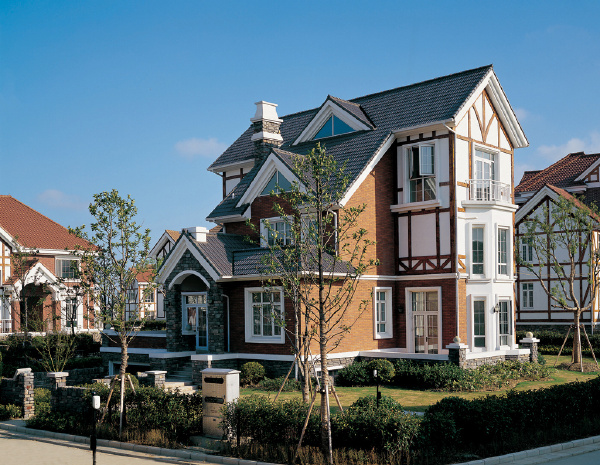Finance and economics: Property in Sweden Home is where the heartache is
財經:瑞士房產,心痛之處是為家
House prices in Sweden continue to soar, to regulators' despair.
瑞典房價持續飆升,監管機構感到絕望。
ASK a central banker what regulators should do when rock-bottom rates cause house prices to soar, and the reply will almost always be “macropru”.
如果要問央行行長,最低利率導致房價飆升時,監管機構該怎么辦,答案通常是“宏觀審慎”。
Raising rates to burst house-price bubbles is a bad idea, the logic runs, since the needs of the broader economy may not square with those of the property market.
按理來說,通過加息消除房價泡沫并不是一個好主意,因為人們對整體經濟的需求與對房地產市場的需求可能不相符合。

Instead, “macroprudential” measures, meaning restrictions on mortgage lending and borrowing, are seen as the answer.
事實上,“宏觀審慎”措施,即對按揭貸款和借款加以限制,才是人們眼中的答案。
But this medicine is hard to administer, as Sweden's housing market vividly illustrates.
但瑞典房地產市場卻生動地表明,這劑藥方很難奏效。
Swedish house prices have doubled in the past decade, their rapid ascent only briefly interrupted by the financial crisis.
過去十年里,瑞典房價翻了一番,這種飛速的上升趨勢僅僅被金融危機短暫地打斷了一下。
So far this year they have risen by about 14%. Apartment prices have been even giddier, rising by more than 150% in ten years.
截至今年,房價上升了約14%。公寓價格漲速更是令人頭暈目眩,10年內已上升逾150%。
In part, this is a simple function of supply and demand.
一部分原因可以歸結為簡單的供需問題。
Stockholm is among Europe's fastest-growing cities, with the recent influx of Middle Eastern refugees only adding to the demand for housing.
斯德哥爾摩是歐洲發展速度最快的城市之一,而由于最近中東難民的大量涌入,人們對房子的需求進一步增加。
Last month the country's migration agency said it expected as many as 190,000 new arrivals by the end of the year, double its previous estimate.
上個月,瑞典移民局表示,到今年年底,預計多達19萬名新移民到來,為之前預期的兩倍。
Sluggish and restrictive planning procedures limit supply: the current shortage of around 150,000 homes is expected to triple by 2025.
遲緩且嚴格的規劃程序限制了房屋供應:當前,約15萬間房屋短缺,到2025年,這一數字將翻三倍。
A counterproductive rent-control regime has crimped the supply of flats in particular, and led to long waiting lists.
租金定價制度產生了適得其反的效果,顯著阻礙了公寓供應,并導致了漫長的等候名單。
Earlier this year an apartment in central Stockholm went to someone who had been in the queue since 1989.
今年早些時候,一名自1989年就開始排隊的人才終于等到了屬于他的一間位于斯德哥爾摩中心地區的公寓。
Low interest rates have given Swedes the capacity to borrow more, pushing prices ever higher.
低利率使瑞典人更有能力繼續借錢,促使價格持續高漲。
The debt of the average household has reached 172% of income after tax.
平均家庭債務已達稅后收入的172%。
For people with mortgages in the big cities, the figure is nearly double that.
對于在大城市的抵押者,該數字將近翻一番。
The most obvious way to calm things down is to raise rates.
平息事態最顯而易見的方法是提高利率。
But the Riksbank, Sweden's central bank, tried that in 2010-11, with disastrous results.
但瑞典的中央銀行瑞典央行(Riksbank)在2010-11年便嘗試過此方法,卻導致了災難性的后果。
Unemployment stopped falling and inflation soon withered, stirring fears of deflation.
失業率停止下降,通貨膨脹很快萎縮,激起了人們對通貨緊縮的恐懼。
That prompted the Riksbank to reverse course in late 2011 and start cutting rates again.
這促使瑞典央行在2011年底改變進程,重新開始削減利率。
The benchmark has ended up lower than it was to begin with, at -0.35%, increasing the sums flooding into housing.
最終,基準降到了-0.35%,比最開始還低,涌向房市的資金增加。
“It's like mopping whilst the tap is running at full flow,” complains one official.
“這就如同大開水龍頭拖地,”一名官員抱怨道。
To try to stanch the flow, the Finansinspektionen (FI) , the country's financial watchdog, has adopted curbs on both lending and borrowing.
為了止住資金流,瑞典金融監管部門瑞典金融監管局(FI)采取了一系列抑制貸款和借款的措施。
In 2013 it tightened capital requirements for mortgages, and since September it has required banks to hold an extra counter-cyclical capital buffer of 1% of all risk-weighted assets, to increase to 1.5% by next June.
2013年,它加強了對抵押貸款的資本要求,自9月起,它要求銀行對于所有風險資產增持額外的1%作為逆周期資本緩沖準備金,到下一年6月,該數字將增至1.5%。
This will help if the property bubble bursts, but clearly has not been enough to stop it inflating.
盡管該舉措將在房地產泡沫破滅時有所幫助,但遠不能阻止通脹。



